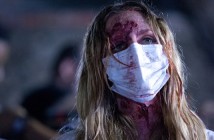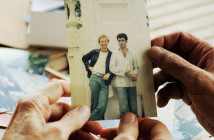The Third One (2014)
Cast: Carlos Echevarría, Emiliano Dionisi, Nicolás Armengol
Director: Rodrigo Guerrero
Country: Argentina
Genre: Drama
Editor’s Notes: The following review is apart of our coverage for Inside Out Toronto: LGBT Film Festival which runs from May 22nd to June 1st. For more information on visit http://www.insideout.ca/ and follow Inside Out on Twitter at @InsideOutTO.
Rodrigo Guerrero’s The Third One (El Tercero, 2014) depicts a pivotal event in a young man’s life, one which shifts how he will forever view the concepts of love and sex. It is a coming-of-age story unlike any other, not only for its portrayal of homosexual relations, but for how it focuses specifically on the impact of sexual experience in a young man’s life. The episodic narrative is segmented through long static takes, affording the viewer with total realism for the brief 70 minute picture. In this time, the film transitions from web-cam flirtations to carnal intercourse as Fede’s (Carlos Echevarría) curiosity and naiveté become ignited and later fulfilled. Beyond this event—the sexual encounter—there is not much to the film. Its purpose and conceivable thesis is undermined by its short run-time and twenty minute final act. This is somewhat disappointing as Guerrero does gesture towards many interesting avenues of inquiry during the first forty or so minutes of the film, only to have it all been fodder for a sexual episode that does little to satisfy.
The episodic narrative is segmented through long static takes, affording the viewer with total realism for the brief 70 minute picture.
The first three scenes of the film take place on the internet. In a 1×1 video-square, taking up less than half the screen space, webcam conversations and internet pornography introduce the viewer to the main characters. In the first scene, a boy is seen showing off his body. He is clearly chatting with someone but only his image is visible. After teasing the camera and showing his underwear, lower stomach tattoo and all visible, the film cuts to another msn instant video messaging chat box. The same boy is again seen, determined by the tattoo he adorns. His face, still yet to be shown, but the viewer realizes that he will be the main character of the story. He is Fede, a 22 year old homosexual who shows interest in older men and the idea of a threesome.
 In the second chat sequence, the viewer is privy to the sounds only coming from Fede’s messaging partner, an older man in a relationship. He brings his lover into the picture, and the three of them flirt via the webcam and chatting tool. Guerrero makes a poignant remark here about how the internet has become a shortcut for meeting people, encountering sexual activity, and for contact. This gesture, however, is never discussed in the film and after a third scene where Fede speaks to yet another couple while intermittently viewing homosexual pornography, the role of the internet is completely abandoned as a source for the film’s themes.
In the second chat sequence, the viewer is privy to the sounds only coming from Fede’s messaging partner, an older man in a relationship. He brings his lover into the picture, and the three of them flirt via the webcam and chatting tool. Guerrero makes a poignant remark here about how the internet has become a shortcut for meeting people, encountering sexual activity, and for contact. This gesture, however, is never discussed in the film and after a third scene where Fede speaks to yet another couple while intermittently viewing homosexual pornography, the role of the internet is completely abandoned as a source for the film’s themes.
When live action begins, it finds Fede in an elevator, looking quite nervous. He arrives at the home of the two men he once chatted with on msn. One of them is a wanker while the other prefers the flesh. The wanker is excited to meet Fede but his lover is a bit apprehensive. All of this is nulled once the dinner scene gets underway. As the three men eat, chat, and drink plenty of wine, they become more talkative and open. In due time, they are revealing intimate aspects of their lives and histories. This scene is done in two takes: the first shot is a very long static shot from behind Fede, and the second is a very long static shot facing Fede. This choice of framing in addition to the intriguing dialogue allows the viewer to get to know the characters—their motivations as well as their behaviours. When the dinner scene ends, so does the film’s sense of storytelling.
It is a subculture that deserves more, and while Guerrero’s The Third One shows promise, it does not quite make the mark needed to fulfill this hole in cinema proper.
Soon after dinner, once the men are a little tipsy, they begin their romantic encounter. While they were up front and uninhibited on webcam, it takes some time for them to be fully immersed in the sensitivities of flesh-to-flesh contact. What comes next is a twenty-or-so minute sex scene comparable to the love scene in Blue is the Warmest Colour (2013). While it is not quite as explicit as Kechiche’s Blue, the homosexual romp depicted in The Third One is extensive and perhaps a little uncomfortable. It really needn’t be nearly as long as it is, and in fact, it makes its point quite strongly in the last few minutes of the scene. The camera shifts from a horizontal position to a straight on position and back to a horizontal position, with the final shot of them in bed looking as if they are standing upright. Fede is sandwiched between the two older men; they create a sexual chain of sorts that only homosexual males could attest to.
The following morning, Fede stands in the elevator with the two men. He smiles and kisses them. This runs parallel to the shot of Fede anxiously riding up the elevator to meet them the night before. When he sits in class, a long take captures Fede cherishing his memory of the night before. He makes the monkey face that the three of them laughed about. He smiles in a way we don’t see before this. He looks confident; he looks changed; he looks like a man. Perhaps this point of change is precisely what Guerrero sought to depict with this film. And if this is the case, he’s certainly done an adequate job. But there is so little to this film that it is hardly a satisfying feat. Homosexuality in the cinema is certainly part of the non-dominant ideology. In almost every case it has been realized by independent filmmakers. It is a subculture that deserves more, and while Guerrero’s The Third One shows promise, it does not quite make the mark needed to fulfill this hole in cinema proper.
The Third One (2014) is a coming-of-age story unlike any other, not only for its portrayal of homosexual relations, but for how it focuses specifically on the impact of sexual experience in a young man’s life.





